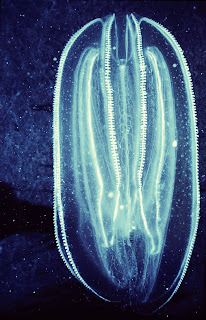Mysterious and beautiful, these little-known animals trap their prey as they drift in the surface waters of the sea. Some use elaborate fishing lines and some give off an eerie light in the dark waters.
These animals must not be confused with jellyfish. Comb jellies’ bodies are not umbrella-shaped and they lack stinging cells. Most have oval or rounded transparent, jellylike bodies, but a few are ribbonshaped. They are predators. Those that “fish” release their two tentacles (fishing lines) from pouches, one on either
side of the body, and trail them in the water. Plankton is caught by special sticky cells on the lines which are then hauled in. Captured food is passed to the mouth on the underside of the comb jelly’s body. The mouth leads to a series of digestive canals that end in minute pores on the top of the body. Comb jellies that lack fishing lines depend on chance collisions with their prey as they move through the water. Flashing Lights
Eight rows of beating, hairlike cilia are arranged around the animal, running from top to bottom. In each row these cilia are formed into “combs,” where the “teeth” are cilia and the back of the comb is hinged to the outside of the animal. All the cilia move together on each comb as it beats back and forth. Each of the eight comb rows has many combs, and when they all beat together they propel the animal through the water.
In the pitch-black ocean depths, where no daylight penetrates, comb jellies may give off pulses (flashes) of greenish or bluish light. These are probably used to frighten away predators.








0 comments:
Post a Comment